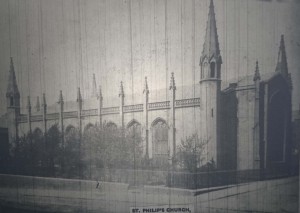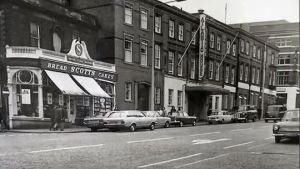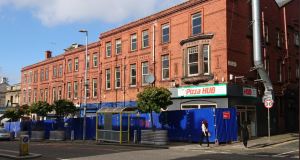Was the Conservation Statement supporting demolition at best inaccurate?
UPDATE: History now completed – Link
Having survived for two hundred years entombed by surrounding buildings St Philip’s is no more. The bulldozers finally came calling.
 St Philip’s was one of three churches in Liverpool designed by Thomas Rickman and constructed by John Cragg proprietor of the Mersey Iron Foundry, in which cast iron was used in new and innovative ways. The church opened in 1816 and closed in 1882 before then being enclosed by other buildings, most latterly Atlantic/Hardman House (a full history will follow). The arguments for and against saving these later buildings is for another day.
St Philip’s was one of three churches in Liverpool designed by Thomas Rickman and constructed by John Cragg proprietor of the Mersey Iron Foundry, in which cast iron was used in new and innovative ways. The church opened in 1816 and closed in 1882 before then being enclosed by other buildings, most latterly Atlantic/Hardman House (a full history will follow). The arguments for and against saving these later buildings is for another day.

 I am now in the process of researching another ‘short-history’ of a lost Liverpool building, but the immediate question in this instance, based on the evidence strewn about us, has to be however ‘was the Conservation Report supporting demolition and the planning application at best inaccurate?’
I am now in the process of researching another ‘short-history’ of a lost Liverpool building, but the immediate question in this instance, based on the evidence strewn about us, has to be however ‘was the Conservation Report supporting demolition and the planning application at best inaccurate?’
You can read or download here the full Conservation Statement which was submitted to support the controversial planning application, and draw your own conclusions. Within it you will read:
5.4 Much less survives at St Philip’s. Were St Philip’s to remain in its original state, it would probably be listed Grade II*. For although no impression of the interior survives to allow a definite judgement to be made, it is probably safe to say that the church would never have compared in terms either of innovation or aesthetic quality with St George or St Michael. What survives of St Philip’s today, however, is so little that any significance it has is almost entirely historical. The only physical features of value are the fragmentary section of the west window (in a modern and inappropriate setting) and the in-situ hood mould. These are features which would not lose what significance they have if they were removed and reset either on site or elsewhere.
The evidence to be seen on the demolition site, some set aside some on pile heaps, seems to suggest otherwise:
At this point in time it is unclear what the developers intentions are with regard to these important relics from one of Liverpool’s most historically important churches. We must hope, were possible, they are restored and put on display along with interpretation boards sharing the history of the church. This could be within the Museum of Liverpool, or a suggestion has been made that they could perhaps form part of a public sculpture within the grounds of the contemporary ‘Bombed Out Church’. Perhaps something within the grounds of the planned student development…as long as fully accessible to the public!
Liverpool Council have been informed of the finds.
“The three cast iron churches erected by Cragg in Liverpool mark an extraordinary episode in church building, and are chiefly remarkable for their pioneering use of cast iron” – Conservation Statement

























We are conservation-accredited architects and are responsible for the continuing care and restoration of St Michael’s and St George’s churches. (Both are grade 1-listed). If St Philip’s had survived it would likely be Grade 1, I suggest. We specialise in this highly unusual form of construction which combines the use of iron and welsh slate. We have proposed an ‘iron trail’ across Liverpool stretching from one church to the other and the remnants of St Philip’s, whereever they eventually reside will be an important point on that trail and the Heritage interpretation that is required needs to link to the two remaining buildings. If anyone wishes to liaise or consult with us we would be delighted to assist.,
Thanks Alex, that sounds a great idea, I hope it comes to fruition. I have just spent another morning in the Archives researching St. Philip’s and am looking forward to putting it all together soon. Please let me know if I can provide you with any information or help with any promotion etc.
Do you have any contact details of the Demolition contractor or developer with whom we can make contact? – if not then perhaps a tweet or two from you (as your following is much greater than ours) or our offer of help would assist. Dealing with cast iron and glass of this age requires particular methods and skills and this ought not to be handled or restored without professional advice. I will in the meantime make contact with Historic England and notify them.
The demolition contractor is Mees Demolition: http://www.meesgroup.co.uk/contact-mees-demolitionuk.html
Developer is Carpenter Investments: https://www.carpenterinvestments.co.uk/contact/
on the way to work back in December I watched the demolition and did not take much notice
but my family tree connected with the church (1862) which I thought was long gone to my shock I noticed the windows rising out of the rubble so I rushed home and got my camera in a race against the yellow JCB I then posted my pictures to the letters echo page and they were posted as no one else was taking any notice of the loss of the windows which were largely intact the way in which they were removed and dumped does not fill me with much hope and I feel they will vanish out of sight out of mind you could say I got to see some thing my ancestors gazed at over a century ago
Yes I was keeping a close eye on the site as well as I had already started the research for the history I am putting together – its is fascinating and sad. I am surprised that the Conservation Statement which accompanied the planning application was not more accurate in terms of what remained of St Philips
I have made contact with Historic England, LCC Planning Dept and all parties agree that it would be wonderful if the remnants of the ironwork be retained in a sensitive manner, if possible incorporated in the public realm in or around the original site of the church. There is a requirement upon the developer to undertake some form of public realm /public art works and it is hoped that proposals will come forward for this. LCC Public Art Officer has been informed but the proposals will only emerge as part of an application to discharge a Planning Condition.
I have also had email exchanges with the developer where they have explained that they have removed the cast iron frames from site for safe storage. It has always been their intention to incorporate salvaged items in a feature within the public realm. They are discussing this with their own architects, but the public realm is unlikely to be open before September 2019, so they have not developed any specific proposals as yet.
I have explained that I am a specialist conservation-accredited architect in cast iron and am responsible for the on-going restoration of the two other remaining grade 1-listed Cragg/Rickman churches in Liverpool. I have offered to assist if required in the repairing and re-siting of these important fragments having experience in the techniques and history of these buildings and work closely with Historic England on this.
I have also offered to explain the background to the ‘iron trail’ proposals which is the linking of the St Michael’s in Aigburth to St George’s in Everton with interactive interpretation provided by the digital agency, Whatever&Co. Being able to tie in the remnants of St Philips in a meaningful manner would be a very important opportunity not to be missed.
I await a further response but am hopeful that continued interest might generate pressure for a meaningful display and proper heritage interpretation. Keep up the good work.
That excellent news Alex. Let me know if I can help at all.
Lots of interesting information coming up in the research.
Like Stephen Cooper (above), I have an interest in St Philip’s through my family history. I am currently researching the life of the 19th Century Liverpool author, Lydia Helen Burton, who was married to the Reverend Charles Henry Burton, the Rector of St Philip’s from 1846 to 1869. Three of the Burton’s children were buried at St Philip’s. As a matter of interest (and a bit gruesome, I know!), do you know if the graveyard was cleared before the new buildings went up, or might they still be there? I will be very interested to hear what further info you have discovered about the church, especially in the mid 19th century.
Hi Matthew, great stuff that’s interesting I did not know about his wife. Yes I have a few interesting snippets relating to Rev Burton and the sad loss of his children. He actually paid for two stain glass windows in the church in their memory.
Yes the burials were removed to Anfield Cemetery in 1882.
I am just about to upload my completed history in which you will find more info. I hope you enjoy it and would love your comments.
I was just checking back to see if you had now uploaded your history of St Philip’s. I see that you have and I’m very much looking forward to reading it!
From your post above, I note that Charles Burton dedicated two windows at St Philip’s to two of his children. Looking at the state of the windows post demolition, I don’t suppose either of these windows have survived?
Rev Burton also dedicated two windows at St Peter and St Paul’s Dinton in Buckinghamshire (where he served after leaving St Philip’s) when his eldest daughter Emeline Lydia died in 1871, and to his wife Lydia Helen when she died in 1877.
In turn, Burton’s second wife Julia dedicated a third window at St Peter and St Paul’s after Burton’s death in 1885.
Hi Matthew, yes all done I hope you find it interesting. Do get back with any comments or queries. Interesting to see your comments ref Rev Burton. There is a chance the windows donated by Rev Burton were removed to the new church in 1882 – see page 42.
Thank you xxx that’s very interesting and informative
I have uploaded your history of st Phillips and very informative it is i wonder if Mr Burton met my ancestors any how as I walk past the site as I work close by I have noticed their is one large window left getting slowly buried under scarp and other items plus a smaller frame also the impression left in cement of one of the two round windows at the gable end before it was demolished I wonder were the window went I tried getting an answer out of mee’s and carpenters and got silence no answer to e.mail they were half hart’ed in pulling said frames out of the rubble and laying them out more damaged by them like every think else in this city student apartments springing up every were with some poor shoddy design all just for money yes students our part of our economy but not unscrupulous developers quick march demolition tactics and a to eager city council planing department slowly air brushing local people out of our own city
The metamorphosis of St Philips is an extraordinary story. You must have had great fun preparing the article as you uncovered each layer of its amazing history. As I mentioned in a post, I am researching the life of Rev Charles Burton’s wife Lydia Helen Burton. There are some wonderful snippets of Burton’s time at St Philips. I was particularly interested in the story of the St Philips Institute. I am quite sure that Lydia would have been one of the ladies involved!
Pingback: Seven Churches in Liverpool in 1859 viewed from the air – velvethummingbee
I to have family links to this church which I have only found out about in the last 2 days. I find the information really interesting and now I just need to download any information and photos when I find out how to do it. it will give my family history a bit of interest especially those in Aus!!!
Thank you for giving us all these interesting facts. Barbara
Good luck with the research!
I found your blog and history very interesting with links to St Phillip’s via my Darby family of Liverpool in the vicinities of Mount St, Hope St and Falkland Street. Thank you –
I’ve recently found out that an ancestor, George Jared was not only a bootmaker at 1 Baltimore St , but also a clerk at St Philips in 1821. I’m looking into as much information as possible about the church. His son (also a George Jared) was the governor of an orphanage for boys on Everton Brow. I believe it might have been associated with St Georges, I’m wondering if there is any kind of link or just a coincidence? I’m waiting till after lockdown to visit Liverpool to find out more about both of them. I studied at Liverpool Poly Art College and had no idea at the time how close I was to my ancestor’s former dwelling.
Great story Jessica. Hope you have success with your research. Thanks for getting in touch, and let me know if I can try and find any info for you
My great grandfather was married in the church in July 1864.
In the 1950s I was taken into the sailors club? for a lemonade by a sailor friend I was too young for a beer.
How strange to have stood in the vicinity where an ancestor had been married.
Great grandfather was also clerk to St Michaels church Upper Pitt street.
Thank you for a great website.
Cheers Len, glad you are enjoying the site.
Excellent site thanks, also found some interesting pics here,
https://www.loc.gov/photos/?q=Liverpool
Pingback: Cragg’s own church | Mike Higginbottom Interesting Times
Pingback: Kirklands, Hardman Street – a lost Peter Ellis building, hiding in plain sight – Bygone Liverpool
Thanks very much for the research. My second great-grandparents, Aaron Berry and Jemima Jones, were married in the church in 1830.